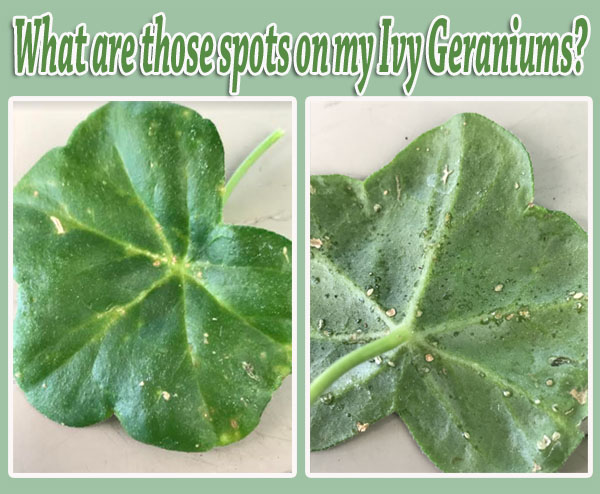Newsletter Articles
What are those spots on my Ivy Geraniums?
By Richard Flowers, ACCNP-Green Thumb Nursery-Ventura
One of the most common and easy to grow plants is Ivy Geraniums. They bloom almost continuously throughout the year and come in a wide variety of colors. Ivy Geraniums are a perfect plant for ground cover and/or hanging basket applications because they trail down the edges of pots or effectively cover large areas of bare ground. On any given day people always ask me about what are the unsightly brown to tannish bumps or spots underneath the leaves? What causes it? And is my plant going to die? There is no reason to be alarmed, your plants are not going to kick the bucket, read on and I will explain to you what this condition is.
What you are experiencing is called Edema and it is a non-infectious disease, meaning it does not spread to other plants and does not make your plants die. Edema is caused when the soil is wet and uptake of moisture is faster than transpiration (water loss through the leaves) causing the leaf cells to rupture resulting in bumps, blisters or crystal-like growth on the undersides of lower or older leaves on Ivy Geraniums and many other types of plants. The upper surfaces of these leaves will often have indentations. The Bumps may turn brownish or tan, become corky, and the plants will become spindly. Severely affected leaves will often turn yellow and fall off the plant. Mildly affected plants often recover, eventually putting out symptom-less new growth in late spring and early summer. Edema occurs when it is foggy, overcast, less sun, and cloudy weather, but can sometimes occur when it is warmer, sunny, and not overcast. This conditions also occurs when the soil remains warm and moist and air is cool and moist. Most plants recover from Edema as soon as growing conditions improve naturally.
To help manage Edema, it is wise to use a well-drained soil and increase spacing between plants so you have better air flow in and around them. You may want to avoid over-fertilizing especially during winter when the plants are growing more slowly. It is also highly recommended to avoid over-watering. Keeping plants more on the“dry side” during extended periods of cloudy, overcast, foggy, high humidity, and cool temperatures is also a good idea. When watering, make sure the plants do not dry out completely. If you have plants growing in pots remember to discard the water that accumulates in the saucer. If the conditions that are causing Edema are caused by an irrigation system, modification to the watering cycle would be necessary. To rule out other similar conditions, it is best to bring in a sample (in a sealed plastic bag) to your favorite Green Thumb Nursery so any of our qualified experts can diagnose the problem.
Do you like what you see? Sign up for our weekly newsletter to get content like this every week!

